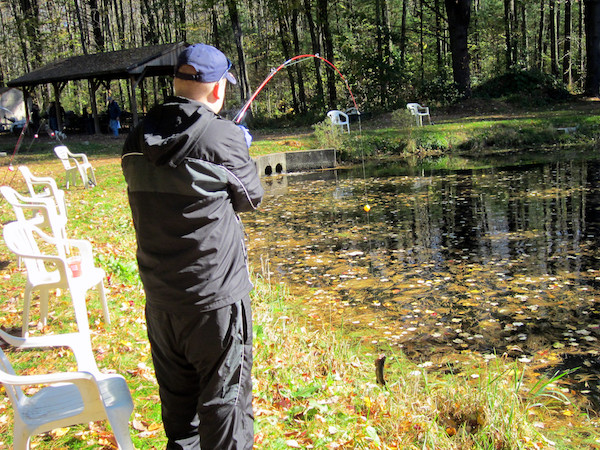SEJournal Online is the digital news magazine of the Society of Environmental Journalists. Learn more about SEJournal Online, including submission, subscription and advertising information.
 |
|
New rules went into effect Sept. 10, 2019, that would expand fishing in many national fish hatcheries, as well as hunting in National Wildlife Refuges. Above, a fisherman lands a trout at the U.S. Fish and Wildlife Service's Richard Cronin National Salmon Station in 2012. Photo: USFWS/Catherine J. Hibbard. Click to enlarge. |
TipSheet: Who Wins in Latest Expansion of Fishing, Hunting at National Refuges, Fisheries?
By Joseph A. Davis
As hunting season approaches, you may find a local story in a new Trump administration push to widen hunting access to National Wildlife Refuges.
Interior Secretary David Bernhardt in June announced a proposed rulemaking that would expand hunting and fishing opportunities in many National Wildlife Refuges and fish hatcheries. Both types of facility are run under the U.S. Fish and Wildlife Service. The set of proposed rules was published June 26 in the Federal Register and the new rules went into effect on Sept. 10.
The backstory
Wildlife refuges are supposed to preserve wildlife. It is a common misperception that they are closed to hunting. Not true. But on refuges, hunting must support the overall mission of conservation.
There are roughly 600 units in the National Wildlife Refuge System, and hunting is currently allowed on some 335 of them. Nearly half of refuge land is in Alaska. Hunting access was also expanded under the Obama administration.
The first federal wildlife refuge (Pelican Island in Fla.) was established back in 1903 by President Teddy Roosevelt. The underlying system for managing the National Wildlife Refuges was later passed in 1966, and updated in 1997 (Public Law 105-57 (text) (PDF).
Why it matters
Fish and wildlife conservation is a critically important public policy goal for many reasons. Most importantly, wildlife play key roles in the interlocking ecosystems of the planet which sustain all life.
Refuges are a protected space where
fish and wildlife can breed, feed,
rest and migrate, keeping populations
from further decline.
Many fish and wildlife species are endangered and diminished by the pressure of human development: farms, roads, cities, etc. Refuges are a protected space where fish and wildlife can breed, feed, rest and migrate, keeping populations from further decline. They are a key part of strategies to protect species designated as threatened and endangered.
Another reason it matters is because people love fish and wildlife. Of course, the refuges are where the ducks are. But visits to refuges are not all about hunting. The 48 million people who visit them annually also enjoy birding, wildlife-watching, photography, hiking, canoeing and environmental education.
Refuges comprise a wide variety of habitat types — from wetlands to forests to prairies. Many play a key role in protecting clean air and drinking water for nearby communities. By one Interior estimate, refuges generate some $3.2 billion for local communities and support more than 41,000 jobs. Refuges are often politically popular.
Story ideas
- First, find out where there may be wildlife refuges or fish hatcheries near you (there is one in almost every state). Inventories can be found on this state-by-state refuge list and on this National Fish Hatchery list.
- Find out if any changes are being proposed in hunting and fishing access to your local unit by checking the new rules.
- Talk to local hunting, fishing and conservation groups to find out what they think of the changes.
- Talk to biologists familiar with the refuge unit to see what effects they think the changes may have. Often such experts are found at nearby universities or research institutes.
- What local environmental benefits do your refuge units or hatcheries offer? Will hunting or fishing access change that?
Reporting resources
- U.S. Fish and Wildlife Service. The main government agency overseeing the refuge system and federal hatcheries (press office).
- Defenders of Wildlife. A nonprofit group advocating and litigating for conservation.
- WildEarth Guardians. Another nonprofit group advocating and litigating for conservation.
- National Wildlife Refuge Association. A nonprofit group advocating for conservation.
- Conservation Alliance. A nonprofit group advocating for conservation, affiliated with outdoor industries.
- Theodore Roosevelt Conservation Partnership. Nonprofit advocating for conservation from the viewpoint of the hunting and fishing industries.
- Association of Fish & Wildlife Agencies. Represents the viewpoint of state agencies.
Joseph A. Davis is a freelance writer/editor in Washington, D.C. who has been writing about the environment since 1976. He writes SEJournal Online's TipSheet and Reporter's Toolbox columns. Davis also directs SEJ's WatchDog Project and writes WatchDog Tipsheet, and compiles SEJ's daily news headlines, EJToday.
* From the weekly news magazine SEJournal Online, Vol. 4, No. 32. Content from each new issue of SEJournal Online is available to the public via the SEJournal Online main page. Subscribe to the e-newsletter here. And see past issues of the SEJournal archived here.














 Advertisement
Advertisement 



